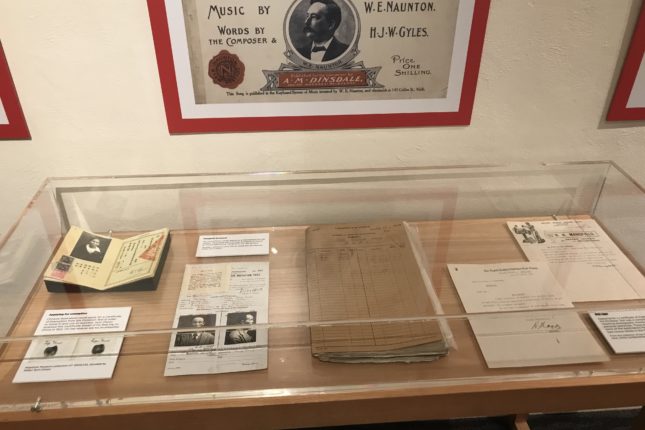
How to recognise if an object needs support
Virtually all items on display require some form of support or protection. Consider each object before placing it on display; examine its condition, the material it is made from and the way it is made. A few simple things to keep in mind are:
- The more fragile an object, the more support it is likely to need.
- Items that have heavy parts such as covers of books or hinged lids on boxes are likely to become damaged without appropriate support.
- Some materials are more sensitive to the external environment. For example textiles, paper and pigments such as watercolours are particularly susceptible to damage from light and UV radiation. Metal items corrode more readily when in contact with uncoated wood.
Safe materials for making your own display supports
Always look for archival quality materials. These include:
- Acid-free cardboard and paper. These can be used for placing under flat items to prevent contact with wooden surfaces such as shelves or the inside of display cases. Wood can produce active chemicals which can damage items. Card or Corflute (a hollow fluted polyethylene plastic board commonly used for signs) can also be folded to create V-shaped supports for books. See the instructions included as an appendix to this Help Sheet.
- Acid free tissue paper: This can be crumpled and used to pad and fill-out the inside of a hat, a pair of boots, or parts of a costume on display.
- Mylar (polypropylene plastic film): This comes in the form of sheets or pockets. Pockets can be used for all sorts of paper items. Two mylar sheets can be sealed on all four sides (with double sided-acid free tape) to encapsulate items. The tape must only come into contact with the Mylar, not the item. Mylar strips can also be used to hold pages of a book open (do not force) or as photo corners (attached to the support not the photograph).
- Tyvek: This is a high-density polyethylene woven material which is often used to protect items such as textiles from dust and water while allowing air to circulate. Tyvek has many other uses in displaying items. It can be placed as a protective layer between objects and shelves or display cases. It can be filled with Dacron (polyester wadding) and sewn into pillow or cushion-type supports which can be used to support book covers or to pad garments. It can be used to cover all sorts of everyday objects such as cardboard rolls or pieces of non-archival foam so they can be used as supports.
- Cotton or calico cloth and Dacron wadding: The cloth can be sewed into pillows and filled with Dacron wadding to make pillow supports for objects and books, display cushions for small items, or padded hangers for garments. See reCollections ‘Caring for Cultural material Volume 2’, (p. 9-10) for instructions for making a padded hanger’ or your own mannequin (p. 19-20)[1]
- Archival foam: This must be covered with Tyvek or cotton so that it doesn’t come into direct contact with an item. It can be cut to all different shapes and used to support objects. For example, a glass bowl might be placed in a shaped foam ring to prevent it moving, thereby reducing the risk of breakage.
Other useful aids for making your own display supports
Cutting board and a steel ruler for cutting archival board and/or a small guillotine for cutting paper
- Sewing kit, cotton tape, tape measure
- Double-sided sticky tape, photo corners
- Cardboard rolls (various sizes) – these need to be covered with cotton or Tyvek
- Various sized wooden display plinths and boxes (sealed)
- Perspex display stands of different sizes
- Polystyrene heads (for hats)
A checklist of things to avoid
A simple rule of thumb is to avoid attaching anything to, or passing anything through, an item. Items can be supported or laid on top of archival supports but should not be attached to them in any way. Steer clear of the following:
- Pins, thumbtacks or staples
- Blue-tac
- Sticky tape, (including non archival standard double-sided tape)
- Glue, adhesives of any kind
- Velcro dots and strips
- Sharp wire
- Wire hangers
- Rubber bands
- Do not laminate original photos or documents. Laminating destroys the historical integrity of an object and it cannot be reversed.
Also watch out for
- Unprotected wooden shelves or display cases. Use acrylic paints or polyurethane for cases and allow these sealants to cure for 2-4 wks before use. Avoid chipboard, masonite and particle board.
- Use of wool felt inside display cases. It emits sulphur gases and attracts insects. Use a sheet of Tyvek instead.
- Display cases that you can’t open easily and safely
- Unsupported, sagging objects such as books, documents, textiles
- Unsupported fragile items such as objects made from glass. They can ‘walk’ their way off shelves due to vibration caused by people walking past.
- Sharp creases and folds in textiles and garments
- Overlapping items without placing a barrier between them such as tissue paper or Tyvek
- Items displayed on the floor or against the walls. Use some kind of support to lift them from the ground.
- Items exposed to constant bright light. See the Museum Environment Help Sheet for pointers on how to avoid this.
[1] Heritage Collections Council, reCollections: caring for collections across Australia, 1998.

